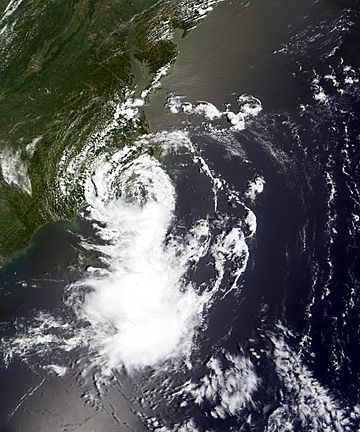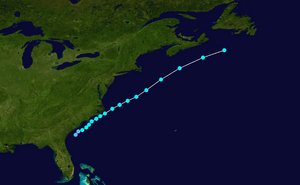Tropical Storm Cristobal (2008) facts for kids
| Tropical storm (SSHWS/NWS) | |

Tropical Storm Cristobal on July 20
|
|
| Formed | July 19, 2008 |
|---|---|
| Dissipated | July 23, 2008 |
| Highest winds | 1-minute sustained: 65 mph (100 km/h) |
| Lowest pressure | 998 mbar (hPa); 29.47 inHg |
| Fatalities | None reported |
| Damage | Minimal |
| Areas affected | Florida, The Carolinas, Atlantic Canada |
| Part of the 2008 Atlantic hurricane season | |
Tropical Storm Cristobal was the third tropical storm of the 2008 Atlantic hurricane season. It started on July 19, 2008, as a weather system off the coast of the southeastern United States. It quickly grew into a tropical storm later that same day.
Cristobal stayed mostly over the ocean, away from land. It reached its strongest point on July 21. The storm then moved northeast along the U.S. East Coast. It finally faded away on July 23 near Nova Scotia, Canada. Because Cristobal was not very strong and never moved onto land, it caused only minor damage. Its main impact was moderate rainfall.
Contents
How Tropical Storm Cristobal Formed and Moved
On July 14, 2008, a weakening weather system brought thunderstorms to northern Florida. The next day, a weak area of low pressure formed near Tallahassee. This low pressure area then moved southeast into the Gulf of Mexico.
It moved back onto land near Tampa on July 16. At first, experts did not think it would get stronger. However, by July 17, thunderstorms around the low pressure area became more active. The system started to get more organized.
Becoming a Tropical Depression
Late on July 18, the National Hurricane Center (NHC) announced that a tropical depression was forming. At 11 p.m. EST on July 18 (which is 0300 UTC on July 19), it was officially named Tropical Depression Three. It was about 65 miles (105 km) southeast of Charleston, South Carolina.
The depression was located between two areas of high pressure. This caused it to move slowly towards the northeast. It became a weak tropical storm during the early afternoon of July 19.
Cristobal's Journey and Strength
At first, Cristobal was not very strong. It had few powerful thunderstorms. Dry air high up in the atmosphere kept it from getting stronger. However, by late on July 20, the thunderstorms became more active.
Cristobal remained a weak tropical storm as it moved close to the coasts of South Carolina and North Carolina. The storm never actually moved onto land. It reached its strongest point on July 21. At this time, it was a strong tropical storm passing east of Cape Hatteras. It kept this strength over the warm Gulf Stream.
As the storm moved into cooler waters, it quickly headed east-northeast on July 21 and 22. By the afternoon of July 22, Cristobal began to weaken south of Nova Scotia. The storm's cloud pattern became messy. On July 23, it changed into an extratropical cyclone. This means it was no longer a tropical storm. The National Hurricane Center issued its last update on Cristobal at 5:00 am EDT (0900 UTC) on July 23.
What Cristobal Did: Its Impact
Before the storm, the National Hurricane Center issued a tropical storm warning. This warning was for the coast from Cape Lookout, North Carolina to the Virginia–North Carolina border.
Impact in the United States
Even before Cristobal fully formed, it brought light rain to Florida. In Lake Wales, about 6 inches (150 mm) of rain fell. Most of this rain came down in just two hours. The heavy rain clogged storm drains, causing some minor flooding. Luckily, the rain did not cause serious problems. It even helped ease dry conditions in the area.
In Wilmington, North Carolina, the storm dropped about 3.43 inches (87 mm) of rain. This led to minor flooding there. Since most of the storm stayed out at sea, winds along the coast were light. The storm surge (when the ocean water rises above normal) reached about 1 foot (0.3 m) above normal along the coast. Stronger winds were reported offshore, but no serious damage was reported on land.
Impact in Canada
Cristobal also brought heavy rain and flooding to Atlantic Canada. At Baccaro Point, on the southern tip of Nova Scotia, a lot of rain fell – 224 mm (8.8 in)! This caused flooding in basements and on streets in Cape Sable.
A sailor from Connecticut needed rescuing southeast of Halifax. A Canadian helicopter helped him after his ship flipped over in the strong waves caused by the storm.
Related pages




